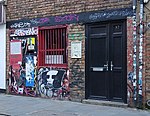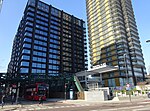Bishopsgate railway station
1840 establishments in England1875 disestablishments in England1964 disestablishments in EnglandBuildings and structures demolished in 2004Disused railway stations in the London Borough of Hackney ... and 9 more
Former Great Eastern Railway stationsFormer buildings and structures in the London Borough of HackneyGrade II listed buildings in the London Borough of HackneyRailway stations in Great Britain closed in 1875Railway stations in Great Britain closed in 1964Railway stations in Great Britain opened in 1840Railway termini in LondonShoreditchUse British English from December 2016

Bishopsgate was a railway station located on the eastern side of Shoreditch High Street in the parish of Bethnal Green (now within the London Borough of Tower Hamlets) on the western edge of the East End of London and just outside the City of London. It was in use from 1840 to 1875 as a passenger station and then as a freight terminal until it was destroyed by fire in 1964. Substantial remains lay derelict until they were demolished in the early 2000s to make way for Shoreditch High Street railway station which now stands on the site.
Excerpt from the Wikipedia article Bishopsgate railway station (License: CC BY-SA 3.0, Authors, Images).Bishopsgate railway station
Bethnal Green Road, London Shoreditch (London Borough of Hackney)
Geographical coordinates (GPS) Address Website Nearby Places Show on map
Geographical coordinates (GPS)
| Latitude | Longitude |
|---|---|
| N 51.5234 ° | E -0.0768 ° |
Address
Boxpark Shoreditch
Bethnal Green Road 2-10
E1 6GY London, Shoreditch (London Borough of Hackney)
England, United Kingdom
Open on Google Maps










